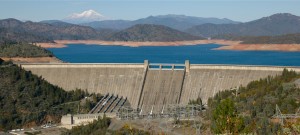 The Bureau of Reclamation has released a draft Environmental Impact Statement and opened a 90-day public comment period on the U.S. government’s proposal to raise the height of Shasta Dam by 18.5 feet. Heightening the dam would flood 5,000 more acres, add 14% more water (an additional 634,000 acre feet) to Shasta Lake during wet years, and require Congressional approval. The estimated cost, according to the EIS: $1.07 billion dollars. Most of the water is destined for agricultural users who can resell the subsidized water. New housing developments and Southern California cities are possible end users of increased water storage behind Shasta Dam. Another possible beneficiary is California’s oil industry, currently ramping up the use of water-intensive hydraulic fracturing (fracking) in the southern Central Valley, raising fears of chemical contamination of groundwater and increased earthquake activity.
The Bureau of Reclamation has released a draft Environmental Impact Statement and opened a 90-day public comment period on the U.S. government’s proposal to raise the height of Shasta Dam by 18.5 feet. Heightening the dam would flood 5,000 more acres, add 14% more water (an additional 634,000 acre feet) to Shasta Lake during wet years, and require Congressional approval. The estimated cost, according to the EIS: $1.07 billion dollars. Most of the water is destined for agricultural users who can resell the subsidized water. New housing developments and Southern California cities are possible end users of increased water storage behind Shasta Dam. Another possible beneficiary is California’s oil industry, currently ramping up the use of water-intensive hydraulic fracturing (fracking) in the southern Central Valley, raising fears of chemical contamination of groundwater and increased earthquake activity.
Native salmon have been blocked from their historic spawning grounds in the upper McCloud, Sacramento and Pit Rivers since Shasta Dam was completed in the 1940s. No bypass for fish species was included in this proposed project. Still, proponents of the dam enlargement argue that making the barrier bigger will benefit the endangered fish, by creating a deeper cold-water pool behind the dam and lowering the temperature of released water. The project would create temporary construction jobs but not increase long-term employment in the region.
If the project goes forward the Winnemem Wintu Tribe would lose ceremonial dance grounds still in use today, sacred sites such as Puberty Rock, along with the flooding of many burials still located at traditional Winnemem village sites. For details please read our McCloud River sacred site report or visit the Winnemem Wintu Tribe website.
There will be three public workshops to discuss the draft EIS, including one in Redding on Tuesday, July 16 at 6pm at the Holiday Inn, Palomino Room, 1900 Hilltop Drive.
The deadline for public comments is September 30. Here’s how you can comment:
By mail: Send comments to Katrina Chow, Project Manager, US Bureau of Reclamation, Planning Division, 2800 Cottage Way, Sacramento, CA 95825-1893
By e-mail: BOR-MPR-SLWRI@usbr.gov
By phone: (916) 978-5067
We’ve prepared a fact sheet about the dam raise for you to download (Word Document): Bureau of Reclamation Talking Points
Here is a sample letter you can download and sign: BoR Letter sacredland.org
Visit www.usbr.gov/mp/slwri to review the full report or for more information.